
FIRST-QUARTER-1994
Please
help us fund the vision of GENI
Dear GENI Friend;
Changes in the world seem to occur
faster than we can integrate their consequences
into our lives. Television brings the face
of war and hunger into our homes. Information
overload is constant for most of us. Yet GENI
is making a clear difference amid the noise.
With high hopes, we watched Israel
and the PLO sign a peace treaty after decades
of conflict. What seemed impossible--a handshake
between Itsak Rabin and Yasir Arafat--was
viewed around the world. Our hearts soared--if
these former enemies can put down their weapons
and work together, isn't it possible everywhere
else?
Then, just a few days later, an article
appeared about Palestinians rebuilding their
homeland. Under the heading Dreaming
Up Peace Projects was the following statement:
With peace at hand,
some ambitious development projects no longer
look so crazy. Beyond Israel and the occupied
territories, some other neighbors could
benefit, too. A few of the Palestinians
fondest dreams: POWER GRIDS: Interlocking
electricity grids could save Israelis and
Arabs millions of dollars. (Newsweek
Magazine, September 20, 1993)
Last year, the GENI initiative was
given to energy planners throughout the Middle
East. Before the peace, most experts
scoffed at the notion. What a difference a
handshake can make!
The GENI
Computer Simulation Model described in our
last newsletter
has begun with an impressive international team.
The goal is to produce a clear-cut cost/benefit
analysis comparing various energy future scenarios.
The model will contrast the economic and environmental
benefits of interconnecting global renewable
energy resources versus the results of other
projected world energy scenarios (such as those
of the World Energy Conference and the Intergovernmental
Panel on Climate Change). The project will support
GENI's ideal of achieving a low-emission sustainable
energy future that supports the economic growth
of developing countries.
We need you continuing help in this
effort. Last year we launched the Campaign
to Fund the Vision of GENI. The goal for
1994 is one million dollars, and while we have
a good start, your financial support is needed
more than ever. We invite your help in making
GENI real in the world. Please use the enclosed
pledge form and contribute at a level appropriate
to your vision.
Thank you for your generous contributions
over the past year. Your financial gifts,
time and expertise ARE making a difference.
Sincerely,
Peter Meisen
Executive Director
|
|
GENI DIRECTORS AND OFFICERS: Len Bateman,
Robert Kiyosaki, Anthony Davis, Floyd Geis,
Nyhl Henson, Mike Fisher, Bill Shopoff
GENI EXECUTIVE DIRECTOR: Peter Meisen
GENI ADVISORS: Raghbir Basi, Brian Bieler,
Milton Byrd, David Cline, Terry Lipman, Karen
Morgan, Robert Muller, Glenn Olds, Malcolm Roberts,
Marshall Thurber
|
Connecting the World's Electrical
Grids
Transmission
systems that send bulk
power over long distances
are proving that global energy
networks are technically feasible if
economic and political incentives surge.
Inventor Buckminster Fuller first
proposed the
idea of connecting the world's regional electrical
grids into a single global energy network in 1969.
Since then, political problems, including domestic
and international conflicts, have posed a formid-
able barrier to global energy networking. How-
ever, the development of long-range trans-
mission systems has bolstered the tech-
nological feasibility of such plans...
Michael Valenti, Associate Editor
Mechanical Engineering
January, 1994
Sending electricity long range
will generate much needed revenue for developing
countries while reducing the need for the construction
of new power plants in the industrial nations.
Joseph Falcon, Past President
American Society of Mechanical Engineers
True Economic Conversion —
Buckminster Fuller's global strategy offers
post Cold War job opportunities
Economic conversion to skilled civilian jobs is
not a new concept to the advocates of such planning.
Yet converting high tech military expertise to marketable
civilian products and services has proven a difficult
task. President Clinton stated his concern in a
speech to an international trade conference. Do
we have anything so far to replace the steep, steep
cuts in defense spending which have gone to the
very heart of a lot of our high-wage, high-tech
economy? He continued, No, we
don't. but we need a technology policy and a defense
conversion policy that attempts to replace that.
The proposed Information Superhighway appears to
be a strong step in this direction yet remains the
darling project of the telecommunications and computer
industries.
In California and across the nation tens of thousands
of engineers are unemployed due to the lack of adequate
conversion planning. With the Cold War over, this
policy vacuum remains. How does one become trading
partners with his former enemy? Can military thinking
transform into market dynamics? There is a common
enemy of the United States, Russia and the rest
of the world in our environmental challenges. As
many experts before him have stated, Paul Kennedy
in Preparing for the 21st Century
warns us that the growing populations and the environmental
stress will soon overwhelm the support system if
we don't change the direction in which we're headed.
What's wanted and needed on the planet is a plan
for the long term sustainable development for our present
5.5 billion people — projected to be 8 billion
in 2020.
More than 20 years ago, the World Game model by
Dr. R. Buckminster Fuller (inventor of Geodesic
Domes, Synergetics, Dymaxion Map) proposed the planet's
highest priority to be the interconnection of electric
grids to tap abundant, but often remote renewable
resources. In Earth in the Balance,
Vice President Gore acknowledges Fuller's vision
for our world.
Reports from the DOE
National Energy Labs highlight the enormous renewable
resource potential in the United States. Energy
Secretary O'Leary has even changed the pictures
in her office from nuclear plants and submarines
to wind and solar farms. And as reported by the
Union of Concerned Scientists, wind and solar thermal
generation are cheaper sources today than natural
gas used for peaking power generation.
California leads the world in alternative energy
production from clean energy resources--wind, geothermal
and solar. The 1992 California Energy Commission
report boasts the Golden State has over half of
the world's geothermal production, more than 80%
of total wind production and 99% of the installed
solar capacity of the rest of the world. Yet these
three sources comprise less than 6% of California's
power generation.
Potentially, Us and Russian engineers could lead
the world in developing renewable energy technologies
for both domestic and international use.
The superpowers defense industries produced the world's
finest engineering expertise, metals fabrication
and computer simulation models. This is the same
proficiency required to take full advantage of the
renewable energy resources around the world.
Pushing
for more efficiency in the developed world has been
the best way for customers and utilities to reduce
expenses and pollution in the past two decades.
Yet the fact remains that 80% of the time we use
energy for anything, we in the first world create
some kind of pollution; CO2, acid rain, toxic wastes.
Global production of these pollutants increases
daily.
Being more efficient is essential, but by itself
is not enough. The have nations
need a plan to drive the transition to a higher renewables
percentage. The ;have-not nations
need an energy infrastructure that will supply their
growing energy demand in a manner that is ecologically
sustainable. The demand for more energy in the developing
nations is immediate. However, families struggling
for survival have little time or attention for preserving
their environment.
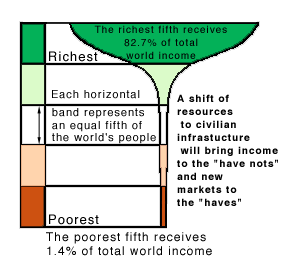 |
| Source: United Nations
Development Program, Human Development Report,
1992 |
Some of the optimal sites for solar, wind, hydro,
geothermal and tidal sources are located in remote
locations, many in the developing world. These energy
treasures are in deserts, mountains, tidal and wind
sites--far from where we choose to work and live--often
times in neighboring nations.
(Source: United Nations Development Program, Human
Development report, 1992)
This power could be delivered via the already existing
transmission networks in developed nations. An uncelebrated
public benefit from the weapons and NASA
research of the last three decades has been the
increased efficiency and extended economic limits
of electric power transmission. Power lines can
deliver renewable energy over thousands of miles
as reliably as that generated by coal and nuclear.
And these renewable technologies are now cost competitive
for peaking power and some base load situations.
While we struggle to find a conversion policy with both
technical and human vision, Japan is designing a
system to provide clean energy for the entire planet.
Sanyo has driven a stake into the future that will
pull everyone towards it.
Some in Japan are now taking Fuller's vision a step further,
and offering us a crystal ball to the future. Sanyo
Electric has proposed Project GENESIS for the mid
21st Century. GENESIS stands for Global Energy Network
Equipped with Soar Cells and International Superconducting
Grids. Even though superconducting power transmission
is still a research dream, Sanyo figures that solar
cells covering just 4% of the worlds deserts could
supply the energy needs of everyone on the planet.
A conversion of Cold War thinking reveals the opportunity proposed
by Buckminster Fuller. The linking of renewable
resources around the world is feasible and desirable
today. With a little vision, engineers could be
back at high-tech, well-paid positions creating
renewable technologies for domestic use, and export
to the rest of the world. Both Russia and the US
should follow Sanyo's lead.
Interconnected Renewable Energy is the Future
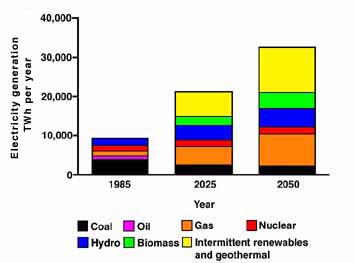 |
|
Electricity generation
for the renewables-intensive global energy
scenario. Renewables can play major roles
in the global energy economy in the decades
ahead. In the global energy demand scenario
for this study, global electricity production
would more than double by 2025, and more
than triple by 2050. The share of renewable
energy generation would increase from
20% in 1985 (mostly hydroelectric power)
to about 60% in 2025, with roughly comparable
contributions from hydropower, intermittent
renewables (wind and direct solar power)
and biomass. The contribution of intermittent
renewables could be as high as 30% by
the middle of the next century.
|
GENI's previous newsletter (1st Quarter 1993)
highlighted the Alternative Energy Futures in
2020 as projected by the World Energy Council
(WEC).
The growth in energy demand will be driven by
the population surge of the developing countries
to over 8 billion people. Yet the WEC forecasts
very little change in the renewable/non-renewable
ratio over the next three decades.
Currently, renewables comprise 18% of the generation
mix, non-renewables (fossil and nuclear) provide
82%. Energy demand is projected to grow between
30% to 100% by 2020. Even the most ecologically
driven WEC case expanded the renewable portion
to only 31%.. All of GENI's discussions with
the International Energy Agency, United Nations
and environmental groups have agreed that these
WEC energy scenarios are not sustainable as
defined by the Intergovernmental Panel on Climate
Change or the Agenda 21 of the Earth Summit.
Fortunately, another scenario has been forwarded
by five internationally respected authors in
the recent book "Renewable Energy: Sources
for Fuels and Electricity," by Thomas Johansson,
Henry Kelly, Amulya Reddy, Robert Williams and
Laurie Burnham, Island Press, 1993. The summary
graph is presented here for what the authors
call the Renewables Intensive Global Energy
Scenario. The authors cite benefits of this
scenario that are not captured in standard economic
models:
- increased economic and social development
in rural areas can help reduce poverty and
slow urban migration
- land restoration through biomass growth
will help prevent erosion and provide wildlife
habitat
- Reduced air pollution caused from the burning
of fossil fuels on both transportation and
power generation
- abatement of global warming as renewable
sources produce no carbon dioxide of other
greenhouse gasses
- diversity of the fuel supply would create
more interregional energy trade, and users
would become less vulnerable to monopolies
or supply disruptions
- reducing the risks of nuclear proliferation
as competitive renewables would reduce the
incentive to build further nuclear supply.
Renewable Energy also
concludes two items central to the GENI initiative.
First that—
The levels of renewable
energy development indicated by this scenario
represent a tiny fraction of the technical potential
for renewable energy. Higher levels might be pursued
if society, for example, should seek greater reductions
in CO2 emissions.
The second conclusion is central to the point
that renewable energy sources are site specific,
oftentimes located in remote areas, and oftentimes
in neighboring countries.
Renewable Energy states
that most electricity produced
from renewable sources would be fed into large
electrical grids and marketed by electric utilities.
The evidence grows stronger that both Buckminster
Fuller and the United Nations Natural Resources
Council were correct in their proposal
of 1971. The question remains if the political
will can redirect nationalistic energy strategies
into a global strategy that benefits everyone.
|
Transmission & Distribution International Expo
 |
| Peter Meisen, Executive Director
of GENI, provides a keynote presentation
at the T&D International Expo in Amsterdam |
GENI first met Dr. Hisham Khatib at the 1992
World Energy Conference in Madrid, and shortly
thereafter received his endorsement of GENI's
investigation. Peter Meisen, GENI's Executive
Director, and Dr. Khatib shared the podium at
the Transmission & Distribution
International Expo in Amsterdam, September
1993. The following are a few highlights of
Dr. Khatib's address:
Dr. Khatib cited figures showing global investment
in generation, transmission and distribution
(T&D)
capital facilities of $1250 billion (US) between
now and the year 2000. T&D will represent
50% to 60% of this global investment.
He argued that poverty, emissions, and pollution
are global problems and demand global solutions.
Accessibility to electricity is crucial to solving
these problems. Today, two billion people worldwide
are without any electricity at all. He stressed
that the need to supply these people with electricity
demands novel ideas including inexpensive distribution
techniques. He estimates by 2050, electricity
may account for 60% to 70% of the energy consumed.
He showed that there are two main ingredients
marking the future of the industry: competition
and transparency. Private Utilities
are going to compete; and services, tariffs,
regulations are becoming more transparent--the
consumer has got choices. Because of these
trends, there will be a growing trade in power,
not just between neighboring countries, but
across neighbor countries to a third country.
All this demands strong interconnections.
Extra high voltage (EHV)
transmission will become more important for
wheeling. Research into EHV in the future is
going to be of paramount importance.
Dr. Hisham Khatib
Chairman, Committee on Energy
Issues in Developing Countries
World Energy Council
|
The Society for Computer Simulation Endorses
GENI
To Mission Earth the GENI project is perceived
as a special global simulation undertaken to
investigate the extent to which and the rate
at which progressive interconnection of the
existing system to new sources and new markets
will be economically profitable and environmentally
acceptable. It is of interest to Mission Earth
because it is global in scope, it is long-term,
and it will have to involve to some significant
extent a consideration and possible inclusion
of at least each of the following aspects of
the global system affected:
- population growth as affected indirectly
by the availability of more power
- economics of power at a number of node points
- environmental consequences (e.g. atmospheric
pollution increases)
- benefits of power in markets reached by
the power system
- quality of life or other index of human
status in each region
- effect of more power in some places upon
international tensions
- the effect of more power upon each nations
or regions GNP
(modified to account for negative effects
upon the environment)
- depletion of any nonreplaceable resources
used in producing power
- the consequences of varying the sequence
of incorporating new sources and other effects
presumed to be smaller
The use of simulation for this purpose is
the next best thing to a crystal ball that works
and has numerical output.
This tool can be used to evaluate a variety
of management and engineering alternatives.
At a later stage, there will have been sufficient
use of the simulation to enable GENI to identify
and demonstrate the probable success of selected
alternative policies for policy makers.
Therefore, we endorse
the project without reservation.
Ben Clymer, Chairman
Mission Earth Activity
Society for Computer Simulation
|
My Pledge to Fund the Vision of GENI
Thank you for your commitment to make the world
work for everyone. Your stand makes a big difference
this year. Please contribute at a level appropriate
to your vision of GENI in the world.
|
Funding needs for 1994: $1,000,000.
Your generous support
is requested.
Request:
Request a GENI Video
Discuss this proposal and share the GENI video
with friends and business associates. (Use the Tell
your friends about this page feature below)
Write
a letter to your political leaders, especially
the Presidents of the U.S. and the U.S.S.R. and the
U.N. Secretary General
Contact
your local media regarding a feature story
on GENI
Arrange
a presentation for GENI at your group's luncheon
or trade conference
Contribute
money or skills to forward the education of this
global opportunity
GENI Support
and Products
- GENI
Video:
What if... a new global option
This 15 minute video has been seen
around the world. Designed for the general public,
it's the best overview of the GENI Initiative. Introduction
by John Denver.
- GENI T-shirts (no longer offered)
"Connect the World with GENI"
— three color shirt along with Dymaxion™
Map and Grid is guaranteed to get attention and
conversation. White shirts with Map in blue and
yellow, Grid and print in red.
- GENI
Brochures
A concise statement on GENI, as well as the benefits
in the areas of economics, the environment, international
trade and cooperation, hunger and overpopulation.
This piece will explain GENI to your firends in
3 minutes.
- GENI
Source Document and Placement on the GENI
Mailing List
You'll receive documentation and
support literature on the Global Energy Grid proposal,
priority mailing of hardcopy GENI Newsletters, and
monthly e-mail updates on the status of this discussion
around the world.
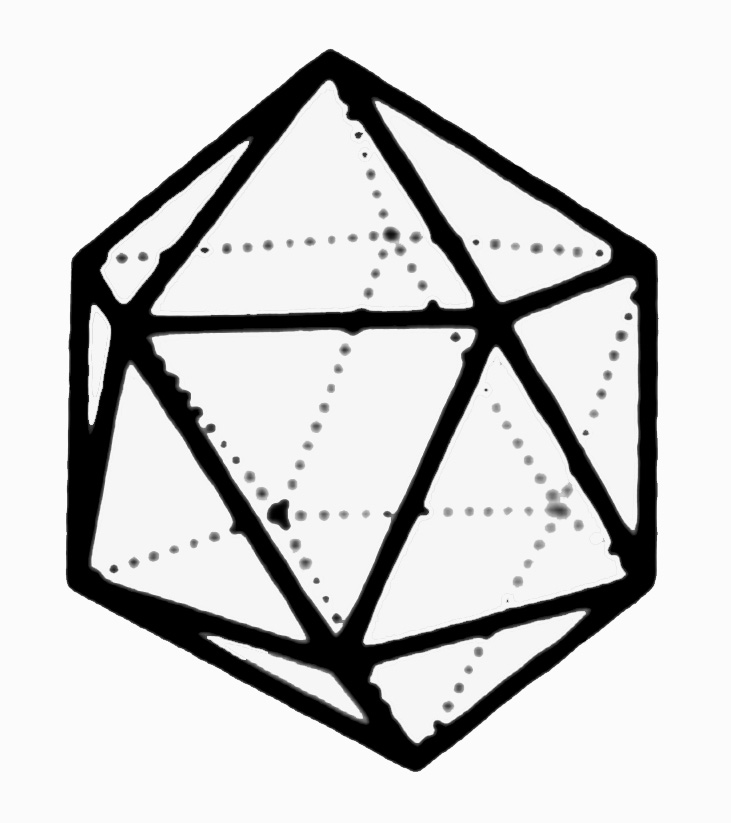 Dymaxion™
Globe Dymaxion™
Globe
Folded from the Dymaxion™ Map,
this four-color 6" globe generates conversation
on global issues and solutions.
- New
GENI Video:
A WIN-WIN Solution
A 15 minute discussion by ten delegates
who participated in the International Workshop in
Winnipeg, Manitoba, Canada in July 1991. The consensus
statement strongly corroborated the GENI initiative
as very credible. It's a win-win
proposal for everyone involved. Joe Falson
- Reports,
Maps, Paper Submissions, and Graphs
Complete set of documents from International
Workshop, Winnipeg, Manitoba, Canada July 1991 —
and Russian/Alaskan Meeting — Anchorage, Alaska,
January, 1992. $75 donation.

Our apologies to the Buckminster
Fuller Institute for inadvertantly failing
to include the following information next
to the image of the Dymaxion™ Map:
The Buckminster Fuller Institute
owns all rights to the Dymaxion™ Map
design. The word Dymaxion™ and the
Dymaxion™ Map design are trademarks of
the Buckminster Fuller Institute. The Map
is copyrighted by the Buckminster Fuller Institute,
1938, and is used here by permission.
|
|
Beautiful four color poster
printed on heavy-gauge paper.
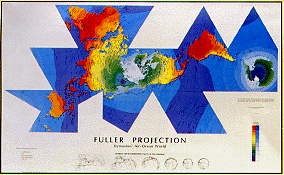
Promises to generate discussions in your
home and office.
GENI MISSION —
To accelerate the attainment of the optimal
sustainable energy solutions in the shortest
possible time for the peace, health and prosperity
of everyone.
|
Two decades
ago, the late R. Buckminster Fuller
proposed interconnecting regional power
systems into a single continuous global electrical
energy grid. • While this vision is still years
away, tech-
nological advances have made the linking of
international and
inter regional energy networks practicable today.
• Transmission
lines allow utilities to level the peaks and
valleys of demand. This is
accomplished between East-West time zones, as
well as North-South
seasonal variations in demand. • The origin
of the energy grid initiative
emerged as the highest priority of the World
Game™. Its stated purpose
is “to make the world work for 100% of humanity
in the shortest possible
time through spontaneous cooperation without
ecological damage or the
disadvantage of anyone.” Research reveals that
these major benefits will
result from expanding electrical networks. •
Increase in everyone’s stan-
dard of living • Reduction of fossil fuel demand
and the resultant pollu-
tion • Relief of the population explosion •
Reduction of world hunger
• Enhancement of world trade • Promotion of
international
cooperation and peace • The purpose of GENI,
Global
Energy Network Institute, is to educate all
people,
especially world leaders, to the potential
benefits of this win-win
solution. •
|
|
"For those who have
seen the Earth from space, and for the hundreds
and perhaps thousands more who will, the experience
most certainly changes your perspective. The
things that we share are far more valuable than
those which divide us."
Astronaut Donald Williams,
from "Home Planet"
|

How can I support
GENI?

|

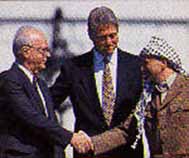



 Dymaxion™
Globe
Dymaxion™
Globe
